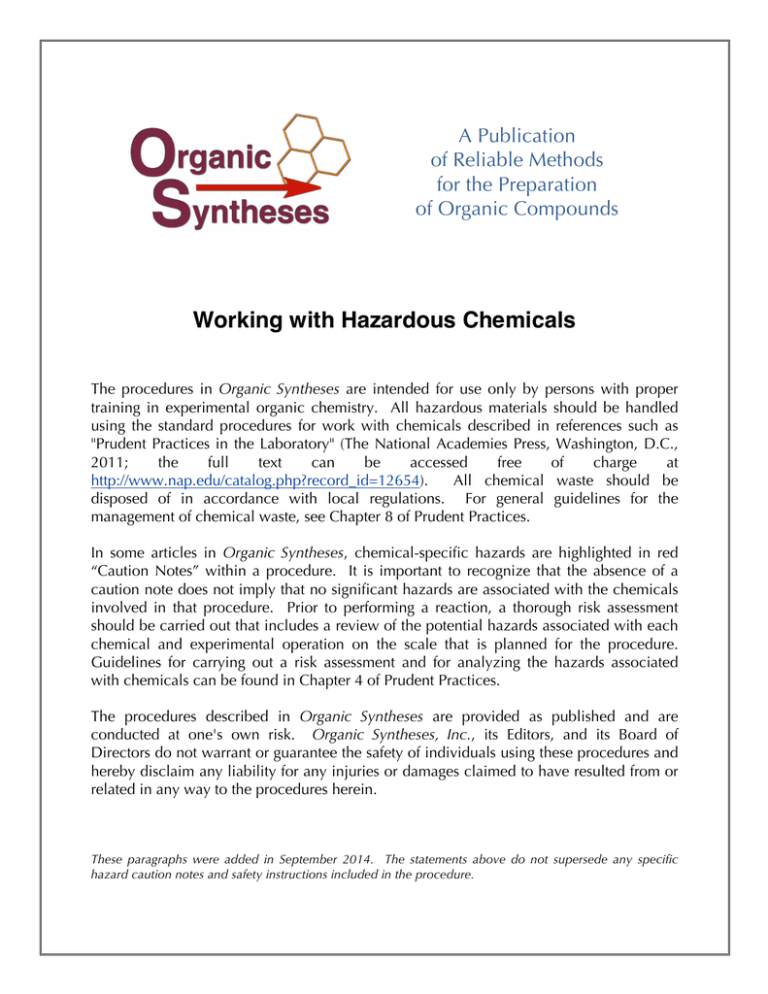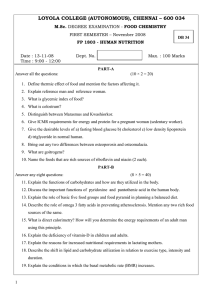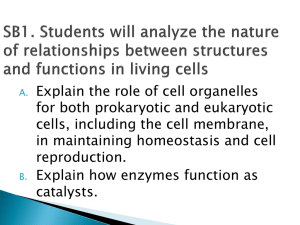
A Publication
of Reliable Methods
for the Preparation
of Organic Compounds
Working with Hazardous Chemicals
The procedures in Organic Syntheses are intended for use only by persons with proper
training in experimental organic chemistry. All hazardous materials should be handled
using the standard procedures for work with chemicals described in references such as
"Prudent Practices in the Laboratory" (The National Academies Press, Washington, D.C.,
2011;
the
full
text
can
be
accessed
free
of
charge
at
http://www.nap.edu/catalog.php?record_id=12654).
All chemical waste should be
disposed of in accordance with local regulations. For general guidelines for the
management of chemical waste, see Chapter 8 of Prudent Practices.
In some articles in Organic Syntheses, chemical-specific hazards are highlighted in red
“Caution Notes” within a procedure. It is important to recognize that the absence of a
caution note does not imply that no significant hazards are associated with the chemicals
involved in that procedure. Prior to performing a reaction, a thorough risk assessment
should be carried out that includes a review of the potential hazards associated with each
chemical and experimental operation on the scale that is planned for the procedure.
Guidelines for carrying out a risk assessment and for analyzing the hazards associated
with chemicals can be found in Chapter 4 of Prudent Practices.
The procedures described in Organic Syntheses are provided as published and are
conducted at one's own risk. Organic Syntheses, Inc., its Editors, and its Board of
Directors do not warrant or guarantee the safety of individuals using these procedures and
hereby disclaim any liability for any injuries or damages claimed to have resulted from or
related in any way to the procedures herein.
These paragraphs were added in September 2014. The statements above do not supersede any specific
hazard caution notes and safety instructions included in the procedure.
DOI:10.15227/orgsyn.066.0151
Organic Syntheses, Coll. Vol. 8, p.119 (1993); Vol. 66, p.151 (1988).
(S)-2-CHLOROALKANOIC ACIDS OF HIGH ENANTIOMERIC
PURITY FROM (S)-2-AMINO ACIDS: (S)-2-CHLOROPROPANOIC
ACID
[Propanoic acid, 2-chloro-, (S)-]
Submitted by Bernhard Koppenhoefer and Volker Schurig1.
Checked by G. Nagabhushana Reddy and James D. White.
1. Procedure
(S)-2-Chloropropanoic acid. In a 4-L, three-necked, round-bottomed flask equipped with a
mechanical stirrer, a 500-mL dropping funnel, and a two-necked adapter fitted with a thermometer and a
reflux condenser (Note 1), 89.1 g (1 mol) of (S)-alanine (Note 2) is dissolved in 1300 mL of 5 N
hydrochloric acid (Note 3). The mixture is cooled to 0°C in an ice/sodium chloride bath (Note 4) and a
precooled solution of 110 g (1.6 mol) of sodium nitrite in 400 mL of water is added dropwise at a rate of
about 2 mL/min under vigorous stirring and efficient cooling so that the temperature of the reaction
mixture is kept below 5°C. After 5 hr, the bath is removed and the reaction is allowed to stand overnight
at room temperature (Note 5). The reflux condenser is connected with a water aspirator and the flask is
carefully evacuated with stirring for 3 hr to remove nitrogen oxides, whereupon the color changes from
yellowish brown to pale yellow. While the mixture is stirred vigorously, 100 g of solid sodium
carbonate is added carefully in small portions so as to prevent excessive foaming. The reaction mixture
is extracted with four portions of 400 mL of diethyl ether. The combined ether layers are concentrated
to ca. 300 mL using a rotary evaporator at atmospheric pressure. The solution is washed with 50 mL of
saturated brine, which thereafter is reextracted with three portions of 100 mL of diethyl ether. The
combined ethereal solutions are dried for 10 hr over calcium chloride. The ether is distilled off with a
rotary evaporator at atmospheric pressure (bath temperature 40–50°C). The oily residue is transferred
into a distillation flask (rinsing the remainder with small portions of ether) and then fractionally distilled
at reduced pressure, the main fraction boiling within a range of 2–3°C (i.e., bp 75–77°C at 10 mm)
(Note 6) to give 63–71 g (58–65%) of an oil. The colorless oil is sufficiently pure for most purposes
(Note 7) and (Note 8). On prolonged standing in a refrigerator, the oil tends to solidify partially or
totally, but the white crystals formed have no sharp melting point. This procedure can be employed for
other α-amino acids (see Table I and the Discussion).
2. Notes
1. If the procedure is carried out under an atmosphere of nitrogen, oxidation of nitrogen monoxide to
nitrogen dioxide is prevented and the reaction mixture remains colorless, but the yield is not improved.
2. The checkers used (S)-alanine of 97% optical purity, purchased from Aldrich Chemical Company,
Inc. The enantiomeric purities of the (S)-amino acids were checked by preparing the corresponding Ntrifluoroacetylamino acid methyl esters, which are resolved into enantiomers by gas–liquid
chromatography on glass capillary columns coated with the chiral stationary phase "Chirasil-Val"2 (see
Table I). For this purpose, an aliquot of the aqueous solution, containing about 0.1–1 mg of the amino
acid, is transferred to a 1-mL vial. Water is removed by a stream of nitrogen and the residue is
transformed to the methyl ester hydrochloride (15% hydrochloric acid in methanol, 110°C, 30 min) and
finally (after drying in a stream of nitrogen) to the N-trifluoroacetyl derivative (trifluoroacetic
anhydride, 110°C, 10 min). This material is dried and dissolved in dichloromethane for GLPC analysis.
The commercially available (S)-amino acids alanine, valine, leucine, and isoleucine usually contained
only negligible amounts (a few parts/thousand) of the (R)-antipode, but occasionally up to 2.5% of the
(R)-enantiomer has been detected in (S)-alanine and (S)-valine. The (R)-enantiomer is almost
completely removed by one recrystallization from water.
3. Concentrated hydrochloric acid is diluted by its own volume with water. Hydrochloric acid (2.4 L, 5
N) is employed for the less soluble (S)-amino acids valine, leucine, and isoleucine.
4. A precipitate of the amino acid hydrochloride that formed on cooling is dissolved during the reaction.
5. The less soluble chloroalkanoic acids (R larger than methyl) separate from the solution as an oil.
6. Sometimes a brownish forerun is observed (bp ≤ 70°C/10 mm for 2-chloropropanoic acid), turning
green in a refrigerator and occasionally undergoing vigorous decomposition. It is therefore
recommended that distillation be interrupted and the flask containing the forerun removed.
7. Redistillation is recommended; overall yields are given in Table I. Enantiomeric purities were
determined after conversion to tert-butyl amides (catalyzed by dicyclohexylcarbodiimide, 30 min at 0°C
in dichloromethane) by gas–liquid chromatography on Chirasil-Val.3 The specific rotation is adulterated
by traces of water (determined by GLC on Porapak using a thermal conductivity detector) and
unidentified brownish impurities. The chiroptical data (see Table I) are taken from double-distilled (S)2-chloroalkanoic acids. Azeotropic removal of water from (S)-2-chloro-3-methylbutanoic acid by
refluxing for 24 hr with dichloromethane in a water separator, followed by repeated spinning band
distillation, yielded specific rotation values of up to −1.79°C.
8. The spectral properties of (S)-2-chloropropanoic acid were as follows: 1H NMR (CDCl3) δ: 1.66 (d, 3
H, J = 6.7), 4.40 (q, 1 H, J = 6.7), 12.0 (s, 1 H; this signal may be broadened and shifted upfield due to
minimal amounts of water); 13C NMR (CDCl3) δ: 20.9, 52.0, 176.0.
3. Discussion
The present procedure is based on the method published by Fu et al.4 The yields are increased by the
very slow addition of an aqueous solution of sodium nitrite to the reaction mixture as well as by a
modified workup procedure, specifically, careful removal of nitrogen oxides and the final
decomposition of their adducts with carboxylic acids by buffering with sodium carbonate.
By using high-efficiency capillary gas chromatography with chiral stationary phases [i.e., ChirasilVal2 and (R)-N-lauroyl-1-(1-naphthyl)ethylamine;5 see also recent publications on permethylated βcyclodextrin6], it has been possible for the first time to determine the degree of racemization during the
substitution reaction that proceeds with overall retention of configuration because of double inversion
via an unstable α-lactone.7 Thus, the maximum degree of inversion amounts to approximately 2.2%,
resulting in a 2-chloroalkanoic acid of ee 95.6% (see Table I) if racemization occurs in the diazotization
reaction, and not in the conversion of the free chloroalkanoic acid to the tert-butylamide employed for
analysis of the enantiomeric composition.3,5,6 The enantiomeric yields given in Table I represent the
lowest values found in various experiments. The degree of racemization at carbon atom 2 is strongly
affected by the alkyl group R (see Table I). Racemization is more pronounced in the case of less
hindered primary and secondary carbon atoms adjacent to the stereocenter. It is interesting to note that
the degree of racemization observed in the diazotization reaction runs parallel to the degree of
racemization observed in aqueous solutions of the amino acids at pH 7.6 at elevated temperature.8
The diazotization in 5 N hydrochloric acid is superior to that in aqua regia,9 where up to 10%
inversion has been observed.10
The method described may also be used for the preparation of the corresponding (R)-2chloroalkanoic acids when starting from unnatural (R)-2-amino acids. For instance, (R)-2aminodecanoic acid has been obtained in high enantiomeric yield by enzymatic cleavage of the racemic
N-chloroacetyl derivative.11 For amino acids containing large alkyl side chains, diazotization at higher
dilution is recommended. For the synthesis of racemic 2-chloroalkanoic acids, the diazotization method
described here appears more convenient than the direct chlorination of alkanoic acids.12
2-Chloroalkanoic acids bearing chiral side groups are useful starting materials for the synthesis of
chiral alcohols of high enantiomeric purity. Thus, (3S)-3-methylpentanol-1 has been obtained from
(2S,3S)-isoleucine via exhaustive lithium aluminum hydride reduction of the chloro acid.13 14 Similarly,
(3S)-1,3-butanediol has been obtained from (2S,3S)-allothreonine.15 The time-controlled lithium
aluminum hydride reduction of 2-chloroalkanoic acids leads to 2-chloro-1-alkanols (chlorohydrins),
which can be cyclized to alkyloxiranes of high enantiomeric purity.16
TABLE I
(2S)-2-CHLOROALKANOIC ACIDS
Reactant
Yield
(%)
Substituent R
(S)-Alanine -CH3
(S)-Valine
64 ± 6 75–77/10
103–
62 ± 5
105/10
113–
58 ± 4
115/10
111–
59 ± 6
112/10
-CH(CH3)2
(S)-Leucine -CH2CH(CH3)2
(2S)-Isoleucine
d20
bp (° ee (%) of Chloro
4
[α]D20 (°)e
a
C/mm)
Acid
(g/cm3)
(3S)-CH(CH3)
CH2CH3
95.6b
1.265
−13.98
97.7b
1.140
−1.44
95.8c
1.082
−31.73
98.3c,d
1.115
−4.78
In each case the starting amino acid was ≥99.8% optically pure, as shown by gas
chromatography of the trifluoroacetyl methyl esters on Chirasil-Val (Note 2).
bBy gas chromatography on the tert-butyl amides on Chirasil-Val (Note 7).
cBy gas chromatography of the tert-butyl amides on (R)-N-lauroyl-1-(1-naphthyl)
ethylamine (5,6).
dDiastereomeric excess, referring to (2R,3S)-2-chloro-3-methylpentanoic acid. Total
composition: 99.0% 2S,3S; 0.8% 2R,3S; 0.2% 2S,3R; approximately 0% 2R,3R. The
starting amino acid was contaminated with 0.2% of the 2S,3R.
eRotations were measured on the neat liquids; specific rotations are given for
material of the indicated enantiomeric excess.
a
This preparation is referenced from:
z
Org. Syn. Coll. Vol. 8, 434
171819
References and Notes
1. Institut für Organische Chemie der Universität, Auf der Morgenstelle 18, D-7400 Tübingen,
Federal Republic of Germany. We thank Mr. E. Koch and Professor E. Bayer, University of
Tübingen, FRG, and Dr. K. Watabe and Professor E. Gil-Av, Weizmann Institute of Science,
Rehovot, Israel, for the determination of the enantiomeric purity of the 2-chloroalkanoic acids.
We thank Deutsche Forschungsgemeinschaft and Fonds der chemischen Industrie for support of
this work.
2. Frank, H.; Nicholson, G. J.; Bayer, E. J. Chromatogr. Sci. 1977, 15, 174.
3. Koch, E.; Nicholson, G. J.; Bayer, E. J. High. Resolut. Chromatogr. Chromatogr. Commun.
1984, 7, 398.
4. Fu, S.-C. J.; Birnbaum, S. M.; Greenstein, J. P. J. Am. Chem. Soc. 1954, 76, 6054.
5. Watabe, K.; Chang, S.-C.; Gil-Av, E., Koppenhoefer, B. Synthesis 1987, 225;
6. Venema, A.; Tolsma, P. J. A. J. High Resolut. Chromatogr. Chromatogr. Commun. 1989, 12, 32.
7. Brewster, P.; Hiron, F.; Hughes, E. D.; Ingold, C. K.; Rao, P. A. D. S. Nature 1950, 166, 179.
8. Smith, G. G.; Sivakua, T. J. Org. Chem. 1983, 48, 627.
9. Karrer, P.; Reschofsky, H.; Kaase, W. Helv. Chim. Acta 1947, 30, 271.
10. Schurig, V.; Koppenhoefer, B.; Buerkle, W. Angew. Chem., Int. Ed. Engl. 1978, 17, 937.
11.
12.
13.
14.
15.
16.
17.
18.
19.
Masaoka, Y.; Sakakibara, M.; Mori, K. Agric. Biol. Chem. 1982, 46, 2319.
Ogata, Y.; Sugimoto, T.; Inaishi, M. Org. Synth., Coll. Vol. VI, 1988, 90.
Koppenhoefer, B.; Weber, R.; Schurig, V. Synthesis 1982, 316;
Schurig, V.; Leyrer, U.; Wistuba, D. J. Org. Chem. 1986, 51, 242.
Hintzer, K. Koppenhoefer, B.; Schurig, V. J. Org. Chem. 1982, 47, 3850.
Koppenhoefer, B.; Schurig, V. Org. Synth., Coll. Vol. VIII, 1993, 434.
Klebe, J. F., Finkbeiner, H. J. Am. Chem. Soc. 1968, 90, 7255.
Gaffield, W.; Galetto, W. G. Tetrahedron 1971, 27, 915.
Horeau, A. Tetrahedron Lett. 1969, 3121.
Appendix
Chemical Abstracts Nomenclature (Collective Index Number);
(Registry Number)
nitrogen oxides
brine
permethylated β-cyclodextrin
calcium chloride (10043-52-4)
hydrochloric acid (7647-01-0)
methanol (67-56-1)
ether,
diethyl ether (60-29-7)
alanine,
(S)-alanine (56-41-7)
2-chloropropanoic acid (598-78-7)
sodium carbonate (497-19-8)
nitrogen (7727-37-9)
sodium nitrite (7632-00-0)
nitrogen monoxide
nitrogen dioxide (10102-44-0)
dichloromethane (75-09-2)
lithium aluminum hydride (16853-85-3)
isoleucine,
(2S)-Isoleucine,
(2S,3S)-isoleucine (73-32-5)
leucine,
(S)-Leucine (61-90-5)
valine,
(S)-valine (72-18-4)
dicyclohexylcarbodiimide (538-75-0)
trifluoroacetic anhydride (407-25-0)
(2S,3S)-allothreonine (28954-12-3)
(S)-2-Chloropropanoic acid,
Propanoic acid, 2-chloro-, (S)- (29617-66-1)
(S)-2-chloro-3-methylbutanoic acid
(R)-2-aminodecanoic acid
(3S)-3-methylpentanol-1
(3S)-1,3-butanediol
(2R,3S)-2-chloro-3-methylpentanoic acid
(R)-N-lauroyl-1-(1-naphthyl)ethylamine
Copyright © 1921-2005, Organic Syntheses, Inc. All Rights Reserved




